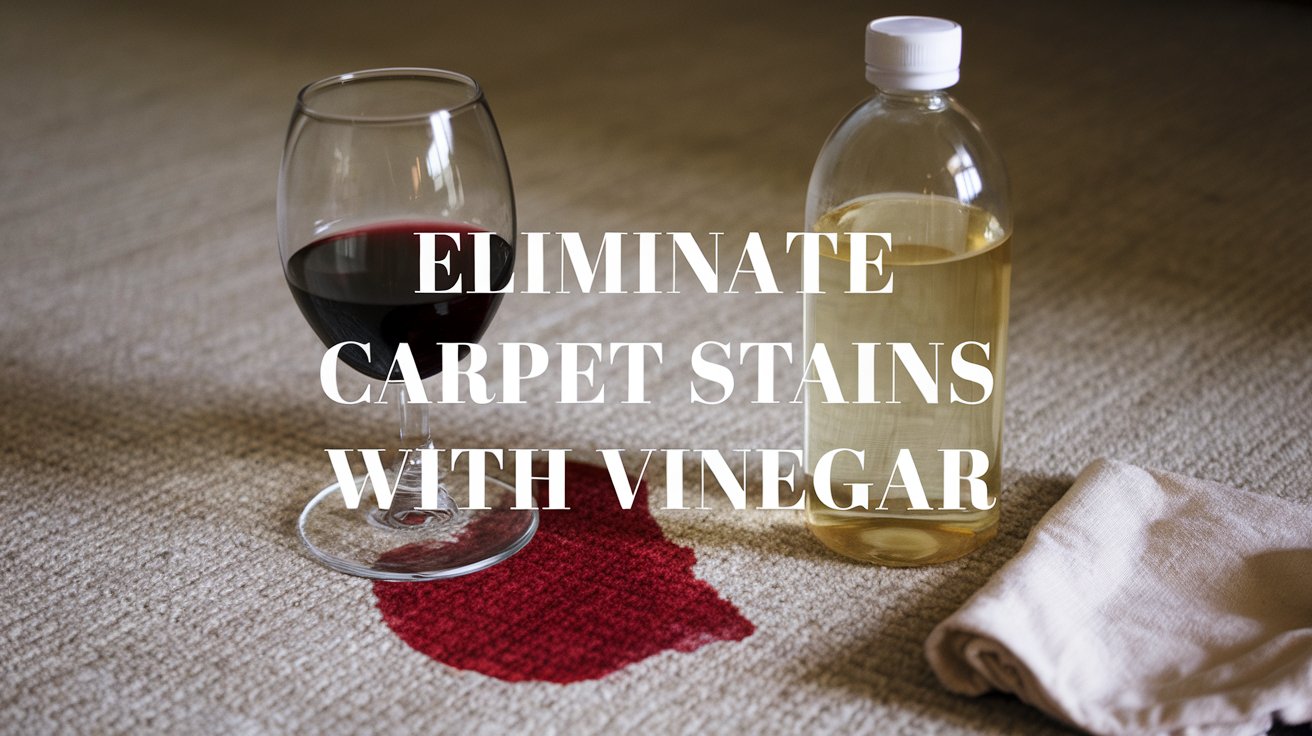Eliminate carpet stains can be a nightmare. Whether it’s a spilled drink, muddy shoes, or pet accidents, stains make even the coziest rooms look messy.
I’ve been there—scrubbing endlessly with expensive cleaners, only to see the stain refuse to budge.
Then I found out about vinegar. It’s an affordable, natural, and highly effective solution.
The beauty of vinegar lies in its simplicity. You probably already have a bottle sitting in your kitchen.
But how does this pantry staple transform stubborn carpet stains? We’re about to explore its cleaning properties and break down how to use it the right way.
With a little patience and a step-by-step process, you can say goodbye to stains without spending a fortune on chemicals.
Disclaimer: While vinegar is a useful cleaning agent, it’s not a substitute for professional cleaning for heavily soiled carpets or delicate materials. Always consult a professional for valuable items or if the stain persists.
Key Takeaways
- Vinegar is a natural and budget-friendly cleaner for carpets.
- Its acidic properties break down many types of stains.
- Using the right process ensures effective stain removal.
Understanding Vinegar’s Cleaning Properties
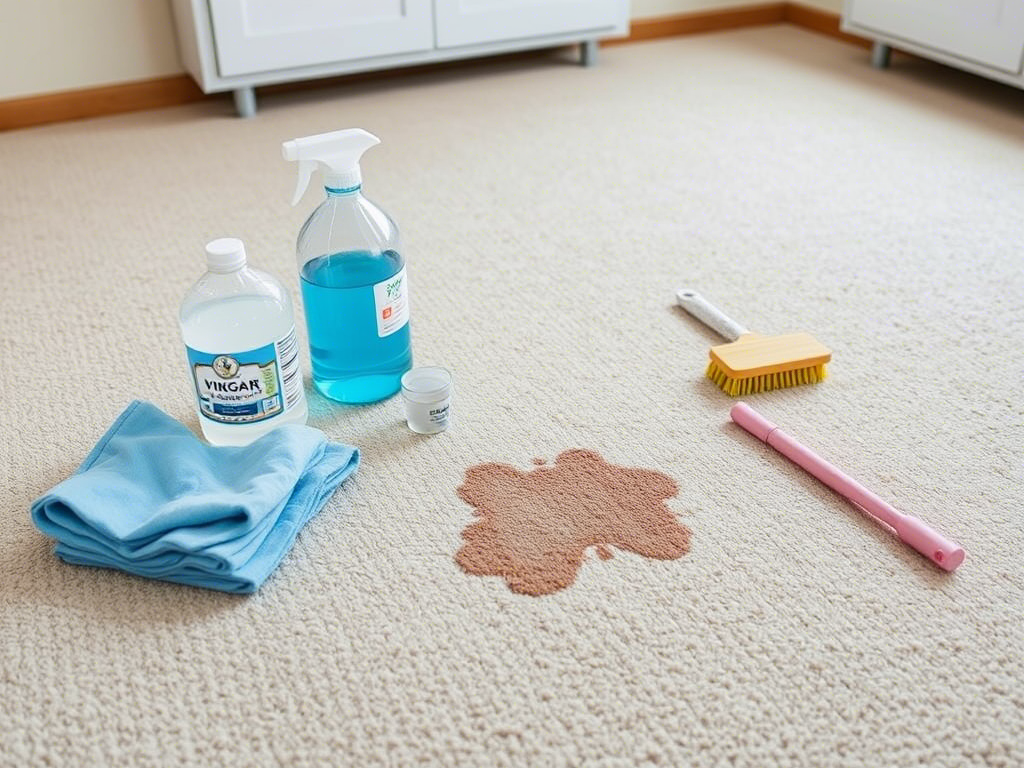
Vinegar is not just for salad dressings. Its cleaning power comes from its main ingredient—acetic acid. This acid helps dissolve dirt, grease, and grime.
According to the U.S. Environmental Protection Agency, acetic acid has some antimicrobial properties, and vinegar can help reduce some germs.
However, vinegar is not a registered disinfectant for carpets, and shouldn’t be relied upon for complete disinfection.
It’s primarily a cleaner and deodorizer. The acidic nature also breaks down organic compounds, which is why vinegar can handle many types of stains.
One key benefit is its ability to neutralize odors. Carpets tend to absorb smells, especially after accidents from pets or food spills.
Vinegar not only removes the visible stain but also helps eliminate any lingering smell.
This dual action—stain removal and deodorizing—makes it a go-to cleaner for many households.
Vinegar is effective on some common household stains, but not all. It’s particularly useful for food and drink spills, as well as some types of dirt.
Some of the most common stains it can tackle include:
- Food and drink spills like coffee, wine, or juice
- Mud and dirt from shoes
- Pet stains and odors
- Grease or oil-based stains (with extra effort)
It’s important to note that vinegar is not effective on all stains. Oil-based stains, blood, and certain inks often require different cleaning agents.
It’s worth noting that vinegar is safe for most types of carpet fibers. However, certain materials, like delicate silk or wool, may react poorly to the acidity.
Other delicate or natural fibers may also react poorly to vinegar. This includes some blends and treated carpets.
When in doubt, consult your carpet manufacturer’s cleaning instructions.
Always test a small, hidden area of the carpet before cleaning a larger spot.
In my experience, using vinegar has saved me time and stress. Once, I spilled red wine on my beige carpet during a dinner party.
I panicked at first but quickly poured some vinegar over the spot.
After a few minutes of blotting and patience, the stain was barely noticeable. It was a game-changer!
Vinegar’s versatility is why I always have a bottle ready. Whether you need a quick fix or deep cleaning, it’s an essential tool for stain emergencies.
Preparing for Cleaning
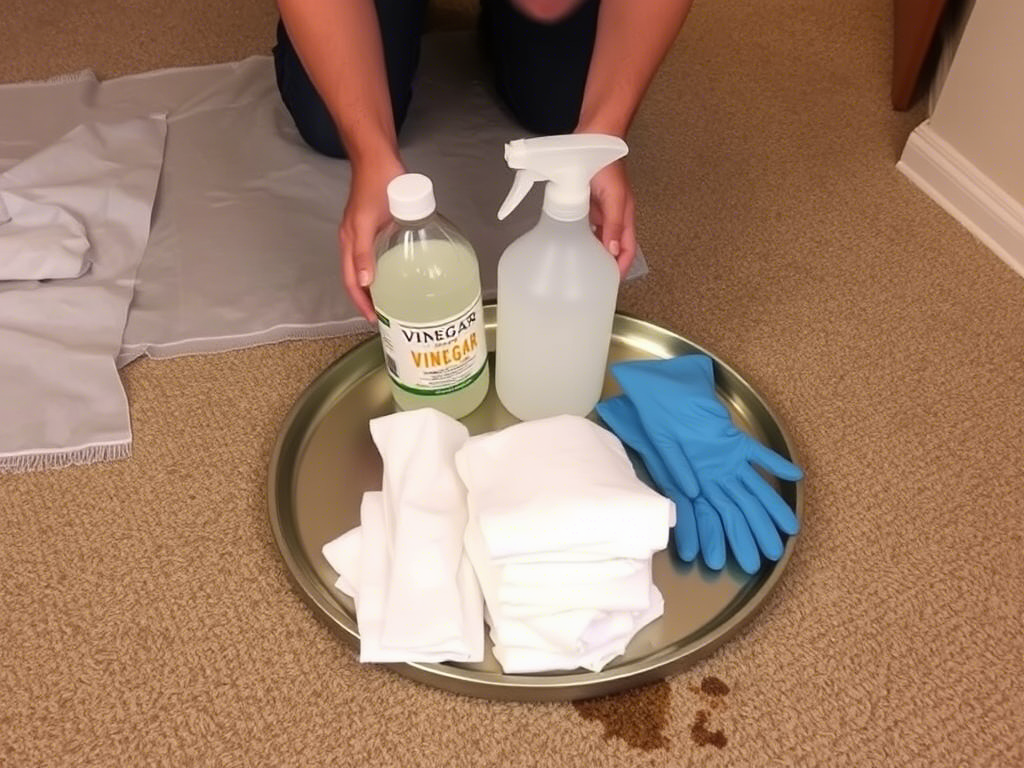
Before you start using vinegar on your carpet, preparation is key. Skipping this step can lead to spreading the stain or damaging your carpet.
Over the years, I’ve learned that having everything ready in advance makes a big difference in how effective the cleaning process is.
Here’s how you can prepare:
- Gather Your Supplies: You’ll need white vinegar, warm water, a spray bottle, clean white cloths or paper towels, and a soft-bristled brush (optional). Avoid using colored towels, as they can transfer dye to the carpet.
- Clear the Area: Move any furniture or items away from the stained spot. This gives you more space to work and prevents further mess.
- Vacuum the Carpet: Vacuuming helps remove loose dirt and debris around the stain. It also prevents rubbing dirt deeper into the fibers when cleaning.
- Test a Small Area: Always do a spot test in an inconspicuous part of the carpet. Apply a small amount of vinegar and water mixture to check for discoloration or damage. Some delicate carpet fibers may react negatively to vinegar’s acidity.
I remember one time I skipped the spot test, and the carpet developed a slightly faded patch. Lesson learned! Always take a few minutes to test before going all in.
By setting up properly, you’ll avoid unnecessary stress and make the actual cleaning process much smoother.
Step-by-Step Cleaning Process
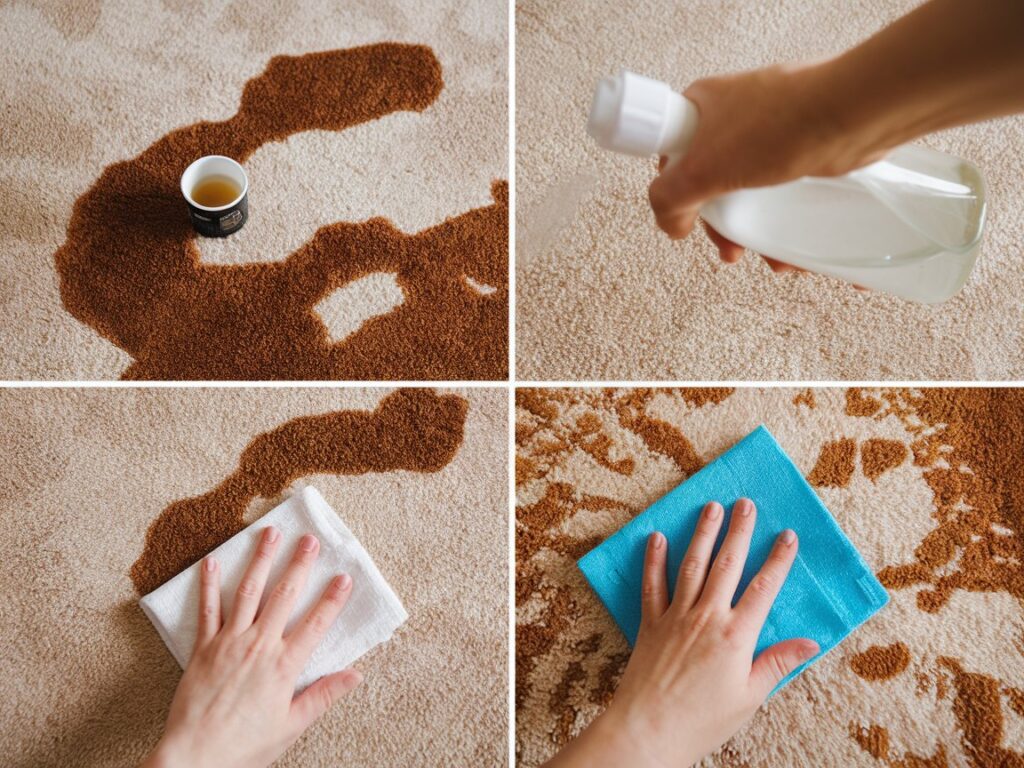
Now that everything is ready, let’s break down the step-by-step cleaning process for using vinegar to remove carpet stains.
This method works well for most common stains like coffee, wine, mud, or pet accidents.
- Blot the Stain: Start by blotting the stain with a clean cloth or paper towel. Don’t rub—rubbing pushes the stain deeper into the carpet fibers. Just gently press down to soak up as much liquid as possible.
- Mix the Solution: Combine equal parts white vinegar and warm water in a spray bottle. For tougher stains, you can increase the vinegar ratio to 2 parts vinegar, 1 part water. Shake the bottle to mix the solution well.
- Spray the Stain: Spray the solution evenly over the stained area. Make sure the spot is damp but not soaking wet. Let the solution sit for about 5-10 minutes. This gives the vinegar time to break down the stain.
- Blot Again: Using a fresh cloth, blot the stain to lift the loosened particles. Repeat this step until the stain starts to fade. Be patient—tough stains may require multiple rounds.
- Scrub Lightly (Optional): If blotting alone isn’t enough, use a soft-bristled brush to gently scrub the area. Avoid scrubbing too hard, as it may damage the carpet fibers.
- Rinse with Water: Spray plain warm water over the area to rinse out any remaining vinegar. This step prevents any leftover vinegar smell from lingering in the room.
- Dry the Area: Blot the spot with a dry cloth until it’s as dry as possible. To speed up the drying process, you can place a fan nearby or open windows for ventilation.
Following this process can help you tackle even the most stubborn carpet stains. I once spilled a full cup of coffee on my cream-colored carpet.
It seemed impossible to clean, but using this exact method, I removed the stain without a trace. It felt like a small victory!
Patience and persistence are essential for stain removal. Trust the process, and you’ll see results.
Special Considerations
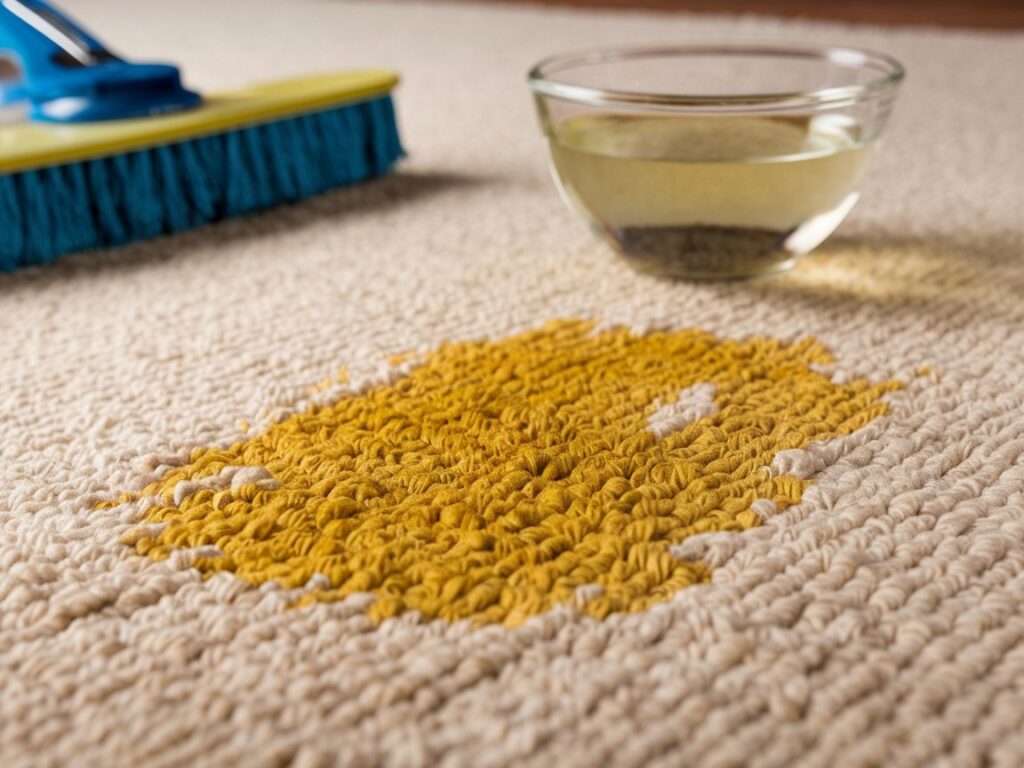
Using vinegar to clean carpets is generally safe, but certain situations call for extra caution.
Different carpet materials and specific stain types may require modifications to the process.
From my own experience, understanding these nuances can save you from damaging your carpet.
Carpet Type Sensitivity
Some materials are more delicate than others. Wool and silk carpets, for example, can be easily damaged by vinegar’s acidity.
Always test a small hidden spot before applying vinegar to the entire stain. If any fading or discoloration appears, stop immediately.
Also, be aware that some carpets are treated with stain repellents that vinegar could potentially damage.
Stain Type
Vinegar is effective for many stains but doesn’t work well on certain types. For example:
- Oil-based stains: Vinegar alone may not fully lift these stains because they need a degreasing agent.
- Blood stains: Cold water is better at breaking down blood. Adding vinegar too soon can make the stain harder to remove.
- Ink stains: Some ink stains may smear or spread if treated with vinegar.
Odor Sensitivity
While vinegar is great for neutralizing smells, its own scent can be strong. Ventilate the area by opening windows or using a fan to help air out the room after cleaning.
Some people are particularly sensitive to the smell of vinegar. While it usually dissipates as the carpet dries, ensure adequate ventilation. You can also use a fan to speed up the process.
Professional Help
For large areas or wall-to-wall carpet cleaning, professional cleaning is often recommended for the best and most even results.
If the stain doesn’t improve after a few attempts or if the carpet is extremely delicate, it’s best to call a professional cleaner. They’ll have specialized tools and solutions for tough stains.
By taking these factors into account, you can avoid potential pitfalls and achieve better results with vinegar-based carpet cleaning.
Preventative Measures
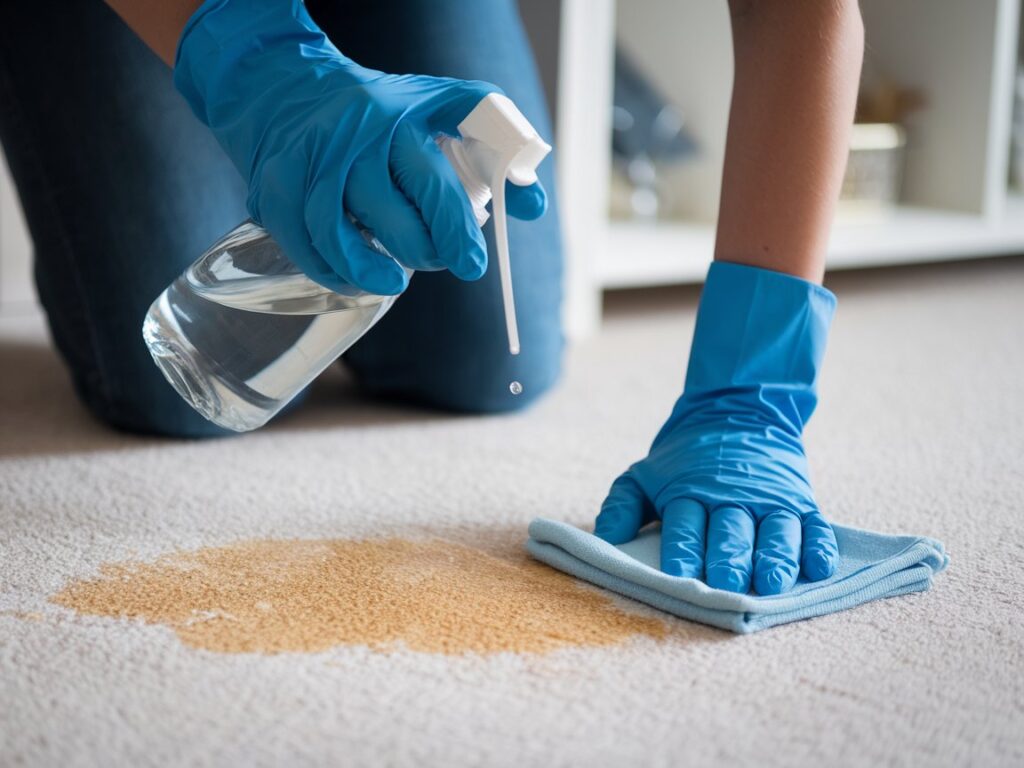
The best way to deal with carpet stains is to stop them before they happen.
While accidents are inevitable, certain habits and routines can reduce the frequency and severity of stains.
Over the years, I’ve developed some simple preventative measures that have helped keep my carpets in better shape.
- Use Area Rugs or Mats: Placing mats near entrances and high-traffic areas can trap dirt and moisture before it reaches the carpet. I’ve found that a simple welcome mat by the front door cuts down on muddy footprints significantly.
- Implement a No-Shoe Policy: Encourage family members and guests to remove their shoes before walking on the carpet. Shoes carry dirt, oil, and grime that can lead to stubborn stains. Offering cozy slippers or socks at the door can make this policy more comfortable.
- Clean Spills Immediately: The quicker you act, the easier it is to remove a stain. Keep a spray bottle of vinegar and water handy for fast cleanup. In my house, this habit has saved us from countless potential stains.
- Vacuum Regularly: Dirt and debris can settle into carpet fibers, making stains harder to remove. Regular vacuuming (at least once a week) helps keep the carpet cleaner and prevents dirt from becoming embedded.
- Apply Carpet Protectant: Some carpet protectants create a barrier that repels liquids and stains. These treatments are especially helpful for households with pets or young children.
By taking these simple steps, you can minimize the need for deep cleaning and extend the life of your carpet.
Accidents may still happen, but being proactive reduces their impact and keeps your carpet looking fresh.
DIY Vinegar-Based Carpet Cleaning Solutions
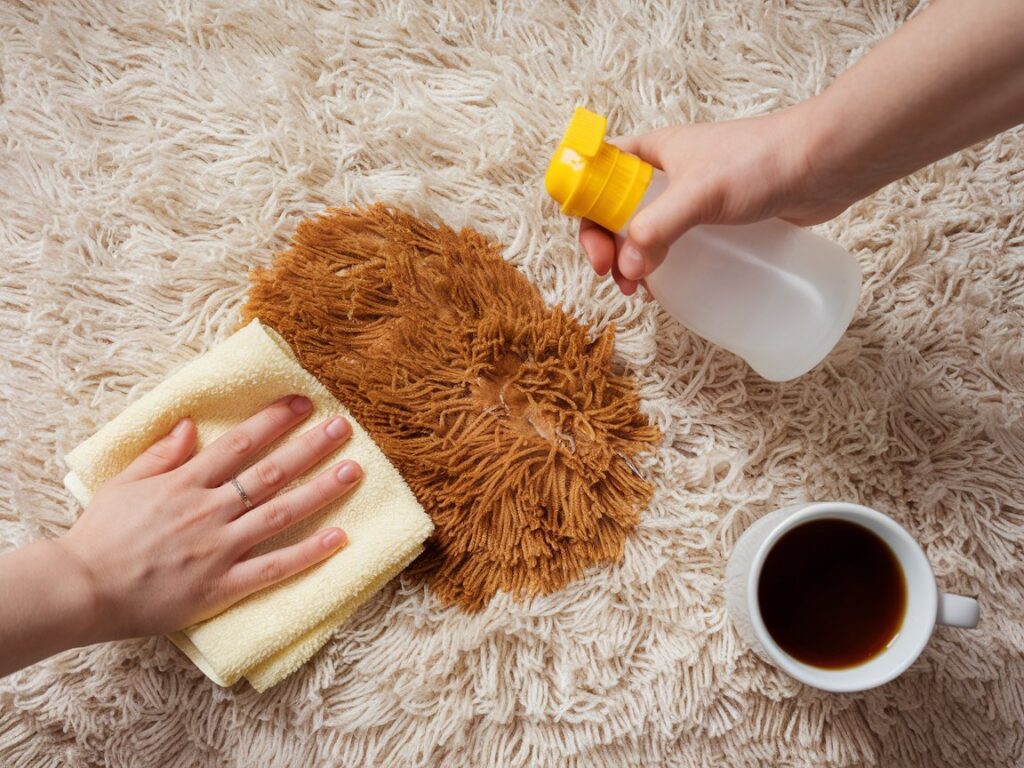
One of the best things about vinegar is its versatility. You can mix it with other household items to create powerful cleaning solutions.
Over the years, I’ve experimented with different recipes to tackle a variety of stains.
These DIY solutions are affordable, easy to make, and surprisingly effective.
1. Basic Vinegar and Water Solution
This is the go-to solution for most carpet stains.
- Ingredients:
1 part white vinegar, 1 part warm water - Instructions:
Mix the vinegar and water in a spray bottle. Spray the stained area and let it sit for 5-10 minutes before blotting with a clean cloth.
Why it works: The acidity of vinegar breaks down stains while water dilutes and lifts them from the fibers.
2. Vinegar and Baking Soda Paste
For tougher stains, this combination is a lifesaver.
- Ingredients:
2 tablespoons baking soda, 1 tablespoon vinegar, water (optional) - Instructions:
Create a paste by mixing vinegar and baking soda. Spread the paste on the stain and let it sit until dry. Vacuum up the dried mixture.
Why it works: Baking soda absorbs the stain while vinegar breaks down the particles. This combo is also great for neutralizing odors.
3. Vinegar and Dish Soap Solution
This solution is ideal for greasy or oily stains.
- Ingredients:
1 tablespoon white vinegar, 1 teaspoon mild dish soap, 2 cups warm water - Instructions:
Mix all ingredients in a spray bottle. Spray the stain and blot with a cloth. Rinse with plain water to remove any soap residue.
Why it works: Dish soap helps break down grease, while vinegar ensures the stain doesn’t linger.
4. Vinegar and Hydrogen Peroxide
This powerful duo can lift stubborn stains like coffee or wine.
- Ingredients:
1 tablespoon white vinegar, 1 tablespoon hydrogen peroxide, 2 cups water - Instructions:
Combine the ingredients and spray the stained area. Let it sit for 10 minutes before blotting.
Caution: Only use this solution on light-colored carpets, as hydrogen peroxide may bleach darker fabrics.
Trying these DIY solutions can save time and money. Once, my dog tracked mud into the house on a rainy day.
The baking soda and vinegar paste worked wonders to lift the dried mud stains.
Common Mistakes to Avoid
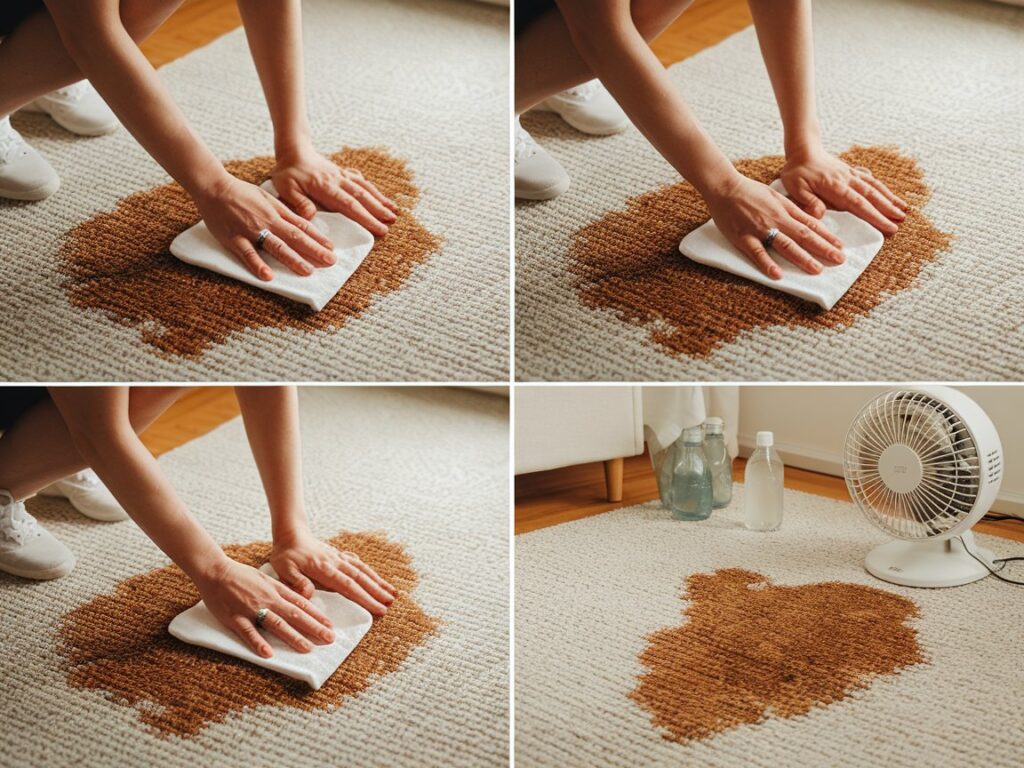
Cleaning carpet stains with vinegar is effective, but certain mistakes can make the problem worse. I’ve learned the hard way, so here are the top errors to avoid:
1. Rubbing Instead of Blotting
It’s tempting to scrub a stain to “force” it out. But rubbing only pushes the stain deeper into the carpet fibers. Always blot gently with a clean cloth or paper towel.
2. Over-Saturating the Carpet
Using too much vinegar or water can soak the carpet padding. This can lead to mold or mildew growth. Spray lightly and blot immediately to avoid excess moisture.
3. Skipping the Spot Test
Some carpets react poorly to vinegar’s acidity. Always test a small, hidden area first. I once treated a stain without testing, only to find a faded patch later.
4. Ignoring the Type of Stain
Different stains need different treatments. For example, greasy stains require dish soap, while pet stains benefit from baking soda. Know the stain type before applying vinegar.
5. Not Rinsing or Drying Properly
Leaving vinegar residue behind can attract dirt and make the carpet look dirty faster. Always rinse with water and dry thoroughly using a fan or open windows.
Avoiding these mistakes can save time, effort, and frustration. In my experience, taking a slow and steady approach always yields the best results.
If you’re patient and careful, vinegar can be one of the best tools for keeping your carpet clean.
How to Buy the Best Vinegar for Carpet Cleaning
When choosing vinegar for cleaning, it’s important to pick the right type to ensure the best results. Here’s what to consider when buying vinegar for your carpet cleaning needs:
- Go for White Distilled Vinegar: White vinegar is the most effective type for cleaning carpets. It has a high acetic acid content, which helps break down stains and odors. Avoid using apple cider vinegar, as it can leave a slight tint and may not be as strong for stain removal.
- Look for a Purity of 5% Acidity: The acidity level is key to vinegar’s effectiveness. Look for vinegar labeled with 5% acetic acid. This is the standard for household cleaning, making it strong enough to tackle most stains.
- Check the Ingredients: Choose a vinegar with minimal additives or artificial colors. The purer the vinegar, the better it will work for cleaning.
- Consider Buying in Bulk: If you clean frequently, purchasing vinegar in larger quantities can save you money. Many grocery stores offer larger bottles or wholesale quantities at a reduced price.
- Avoid Flavored Vinegar: Stick to plain white vinegar. Flavored or infused vinegars, like those with herbs or spices, may leave unwanted smells or residue behind on your carpet.
For a great vinegar option, I recommend Heinz Cleaning Vinegar. It’s a popular choice due to its high acidity (6%) and powerful cleaning capabilities, making it perfect for tackling stains and odors on carpets.
You can find it on Amazon for easy purchase. Here’s a link to check it out:
Heinz Cleaning Vinegar on Amazon
This product is affordable, reliable, and highly rated by customers for its effectiveness in various cleaning tasks.
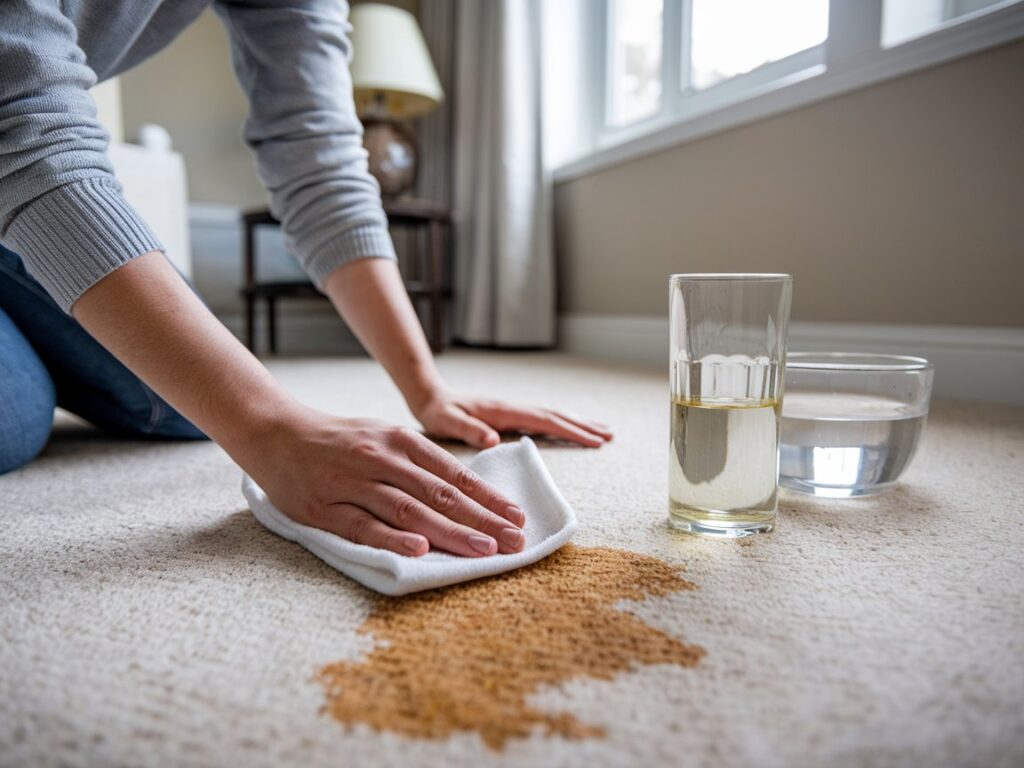
FAQs about Eliminate Carpet Stains
Final Thoughts
Eliminate carpet stains with vinegar is a simple, affordable, and effective solution.
It’s been my go-to method for years, especially with kids and pets in the house.
The best part? You don’t need fancy products or chemicals—just a few basic ingredients and a little patience.
Remember to prepare your supplies, follow the step-by-step process, and avoid common mistakes.
With practice, you’ll get more confident handling those inevitable spills and messes.
And don’t forget to take preventative measures, like using area rugs or a no-shoes rule, to minimize future stains.
If you’re dealing with a particularly stubborn stain or a delicate carpet, don’t hesitate to reach out to a professional.
But for everyday messes, vinegar can work wonders. Give these tips a try, and I’m sure you’ll be surprised at how well they work! 😊
